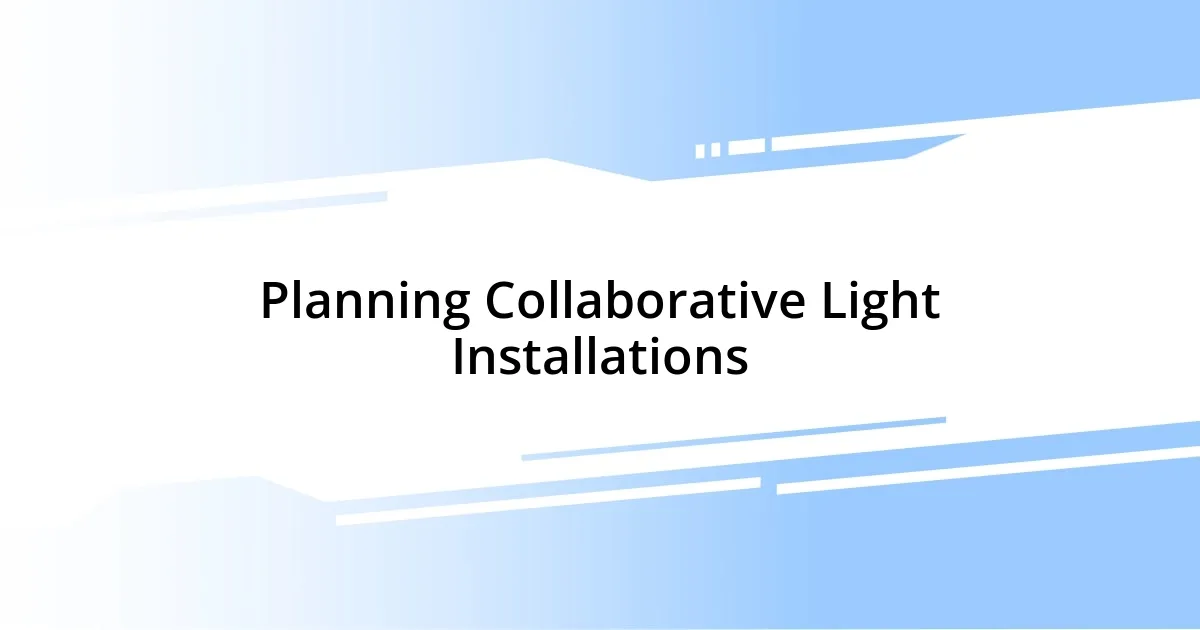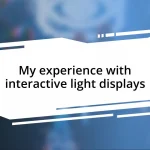Key takeaways:
- Choosing projects with emotional impact and shared values enhances fulfillment and success in light installations.
- Open communication, mutual respect, and shared goals are vital for building strong collaborative relationships.
- Effective planning and documentation streamline the implementation process and foster innovation, especially during challenges.
- Evaluating success involves gathering audience feedback and tracking engagement metrics for future improvement.

Choosing the Right Project
Choosing the right project is such a critical step in the journey of light installations. I remember when I first faced this decision; I was drawn to a community art project that aimed to transform a neglected space. The excitement of bringing art to life in a public area really resonated with me. Have you ever found yourself passionate about a cause that just clicks?
One thing I’ve learned is to consider not just the aesthetic potential, but the emotional impact of the project. For example, when I collaborated on an installation for a mental health awareness event, it was incredibly rewarding to create a piece that fostered connection and dialogue. That sense of purpose made all the difference. What kind of message do you want your project to convey?
It can be tempting to chase big, flashy projects, but I’ve found that the most fulfilling collaborations often stem from genuine connections and shared values. A smaller installation I worked on with local artists turned out to be a highlight of my career simply because we were all so invested in its success. Have you thought about the values that align with your own vision?

Understanding Light Installation Techniques
Understanding light installation techniques can be a fascinating journey. I’ve experimented with various methods, and each technique offers its own charm and challenges. For instance, I once used a string light technique for a cozy outdoor event. The soft glow created an inviting atmosphere that truly enhanced the experience for everyone present. Can you imagine how different the event would have felt with harsh lighting?
In my experience, knowing the right placement of lights is vital. I learned this firsthand during an indoor installation where I strategically placed spotlights to highlight certain art pieces. This not only drew attention to the artwork but also created intriguing shadows that added depth to the space. Have you considered how lighting can fundamentally change the perception of art?
Lastly, embracing technology has transformed my approach to light installations. During one project, I utilized smart LED systems that allowed me to adjust brightness and colors in real-time. This capability really impressed the audience and added a dynamic layer to the installation. Have you explored the possibilities that modern technology can bring to your projects?
| Technique | Details |
|---|---|
| String Lights | Soft glow; perfect for creating ambiance |
| Spotlights | Highlights specific elements; creates shadows for depth |
| Smart LEDs | Dynamic adjustments; enhances audience engagement |

Building Collaborative Relationships
Building strong collaborative relationships is essential in the realm of light installations. I recall a particularly impactful collaboration where I partnered with a diverse group of artists, each bringing unique perspectives to the table. It was fascinating to witness how our different backgrounds enhanced the creative process, ultimately leading to a richer final piece. Have you ever felt how valuable it is to unite various viewpoints in a project?
To cultivate meaningful partnerships, I’ve discovered a few key practices that have proven effective:
- Open Communication: Keeping the dialogue flowing fosters trust and transparency. I’ve seen how candid discussions can prevent misunderstandings before they arise.
- Mutual Respect: Valuing each contributor’s ideas creates an inclusive environment, leading to innovative solutions. A recent collaboration reminded me that everyone’s input is vital.
- Shared Goals: Aligning on a unified vision keeps the team on track and motivated, turning a vision into reality. It’s exhilarating when everyone feels invested in the outcome.
Every collaboration I’ve been involved in taught me that relationships are built not just on ideas, but on shared experiences and genuine connections. For me, the joy of co-creating with others is a reminder of the power of collaboration—a beautiful interplay of creativity and camaraderie. Have you ever found inspiration in working closely with others?

Planning Collaborative Light Installations
Planning collaborative light installations requires thoughtful consideration from the outset. In one of my projects, I vividly remember gathering everyone for a brainstorming session. The energy in the room was electric as we tossed ideas around—who knew that a simple concept could morph into something truly enchanting? It struck me how early conversations could shape the entire direction of our installation, laying the groundwork for creativity to blossom.
When I plan these installations, I’m always keenly aware of the logistics involved. For instance, during another collaboration, we ran into some unexpected challenges with power supply and cable management. Instead of panicking, we turned it into a team-building moment, cleverly designing around the limitations. Have you ever noticed how such hurdles can often lead to the most innovative ideas?
Budgeting also plays a crucial role in the planning phase. In one memorable project, we had to make tough decisions on what materials to prioritize. It was a balancing act, but it forced us to creatively stretch our resources. I discovered the beauty in repurposing materials—who knew that discarded objects could be transformed into breathtaking light fixtures? Reflecting on it, it really gets me thinking about how constraints can sometimes ignite our most imaginative solutions. Have you explored the hidden potential within limitations?

Implementing Design Concepts Effectively
Implementing design concepts effectively involves translating ideas into tangible action, a challenge I’ve embraced in numerous projects. I remember a time when we had an intricate vision for a festival installation, but initial sketches felt flat. This realization pushed us to dive deeper, exploring materials and light effects that could breathe life into our ideas. Have you ever felt that spark of realization transforming a concept into something extraordinary?
Execution demands meticulous attention to detail. During one installation, we faced the task of aligning our lighting with architectural features. I vividly recall the moment when we adjusted the angles, and the light began to dance on the surfaces, revealing textures we hadn’t noticed before. That moment reminded me of how crucial it is to test and adapt throughout the process. What adjustments have you made in your projects that led to unexpected moments of beauty?
In my experience, documentation plays a significant role in effective implementation. After a collaborative session, I learned to keep detailed notes and photos of lighting arrangements, referencing them when things got hectic. It became a lifeline, anchoring our vision amid the chaos of installation day. Have you ever relied on your notes to guide you back to the core of your design? This simple act strengthened our execution and ensured we all remained aligned with our original intentions.

Evaluating Installation Success
Evaluating the success of light installations goes beyond simply assessing visual appeal; it involves a comprehensive review of teamwork and problem-solving dynamics. One project stands out in my memory, where we conducted a post-installation meeting that felt less like analysis and more like a celebration. We reflected on what worked, what didn’t, and how we could enhance our collaborative synergy for the next time. Have you ever realized that the backbone of success is often how we communicate with one another throughout the project?
I like to view feedback as a crucial tool for growth. While installing a series of interactive light sculptures, we gathered insights from the audience. Their reactions were invaluable; they helped us see the installation from fresh perspectives. I remember one visitor’s comment about how the lights evoked fond memories of childhood. This emotional connection was something we hadn’t anticipated, but it highlighted our achievement in creating an engaging experience. How often do you seek input from your audience to gauge your success?
Lastly, I find that tracking metrics related to the installation can provide tangible validation of our efforts. During a recent showcase, we analyzed visitor engagement through foot traffic and time spent at each installation. The numbers revealed not only a high turnout but also a lingering curiosity around specific light features. This data collection sparked discussions in our team about areas for further exploration in future projects. What metrics do you consider important for evaluating your work’s impact?

Documenting the Collaborative Process
Documenting the collaborative process is an essential part of turning innovative ideas into successful light installations. I remember when we began a project with a team brainstorming session. Each member brought a unique perspective, and I felt that energy buzzing in the room. By recording our discussions, I learned not just to capture ideas but to understand the collective vision we were crafting.
During one of our chaotic installations, we hit a snag. I quickly pulled out my phone to reference images of previous arrangements that had worked well. This small act felt like a lifeline, grounding us during the frenzy. Have you ever found that your past documentation saved you during a challenging moment? It’s incredible how reviewing old notes can rekindle inspiration and ensure everyone is on the same page, even when the heat is on.
In my experience, reflecting on the documentation after each project can yield profound insights. After a significant installation, I always jot down what strategies helped us succeed and what fell short. This practice not only informs our future collaborations but also deepens trust within the team. Essentially, have you ever realized how documentation can evolve your relationships with your collaborators? By sharing these reflections, we strengthen our connection and grow together, continuously improving our collective journey.














